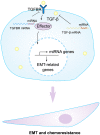Cytokines, breast cancer stem cells (BCSCs) and chemoresistance
- PMID: 30175384
- PMCID: PMC6119679
- DOI: 10.1186/s40169-018-0205-6
Cytokines, breast cancer stem cells (BCSCs) and chemoresistance
Abstract
Chemotherapy resistance of breast cancer poses a great challenge to the survival of patients. During breast cancer treatment, the development of intrinsic and acquired drug resistance tends to further induce adverse prognosis, such as metastasis. In recent years, the progress of research on cytokine-modulated tumor microenvironment and breast cancer stem cells (BCSCs) has shed light on defining the mechanisms of drug resistance gradually. In this review, we have discussed cytokine regulation on breast cancer chemoresistance. Cytokines can affect tumor cell behavior or reprogram tumor niche through specific signaling pathways, thereby regulating the progress of drug resistance. In addition, we summarized the mutually regulatory networks between cytokines and BCSCs in mediating chemoresistance. Cytokines in the tumor microenvironment can regulate the self-renewal and survival of BCSCs in a variety of ways, sequentially promoting chemotherapeutic resistance. Therefore, the combinational treatment of BCSC targeting and cytokine blockade may have a positive effect on the clinical treatment of breast cancer.
Keywords: Breast cancer stem cells (BCSCs); Chemoresistance; Cytokine; Tumor microenvironment.
Figures




Similar articles
-
Enhanced SLC34A2 in breast cancer stem cell-like cells induces chemotherapeutic resistance to doxorubicin via SLC34A2-Bmi1-ABCC5 signaling.Tumour Biol. 2016 Apr;37(4):5049-62. doi: 10.1007/s13277-015-4226-0. Epub 2015 Nov 6. Tumour Biol. 2016. PMID: 26546432
-
Breast Cancer Stem-Like Cells in Drug Resistance: A Review of Mechanisms and Novel Therapeutic Strategies to Overcome Drug Resistance.Front Oncol. 2022 Mar 21;12:856974. doi: 10.3389/fonc.2022.856974. eCollection 2022. Front Oncol. 2022. PMID: 35392236 Free PMC article. Review.
-
Long Noncoding RNA LBCS Inhibits Self-Renewal and Chemoresistance of Bladder Cancer Stem Cells through Epigenetic Silencing of SOX2.Clin Cancer Res. 2019 Feb 15;25(4):1389-1403. doi: 10.1158/1078-0432.CCR-18-1656. Epub 2018 Nov 5. Clin Cancer Res. 2019. PMID: 30397178
-
The Role of Breast Cancer Stem Cells in Chemoresistance and Metastasis in Triple-Negative Breast Cancer.Cancers (Basel). 2021 Dec 9;13(24):6209. doi: 10.3390/cancers13246209. Cancers (Basel). 2021. PMID: 34944829 Free PMC article. Review.
-
Pharmacological targets of breast cancer stem cells: a review.Naunyn Schmiedebergs Arch Pharmacol. 2018 May;391(5):463-479. doi: 10.1007/s00210-018-1479-3. Epub 2018 Feb 23. Naunyn Schmiedebergs Arch Pharmacol. 2018. PMID: 29476201 Review.
Cited by
-
The tumor microenvironment as driver of stemness and therapeutic resistance in breast cancer: New challenges and therapeutic opportunities.Cell Oncol (Dordr). 2021 Dec;44(6):1209-1229. doi: 10.1007/s13402-021-00634-9. Epub 2021 Sep 16. Cell Oncol (Dordr). 2021. PMID: 34528143 Review.
-
Epstein‑Barr virus as a promoter of tumorigenesis in the tumor microenvironment of breast cancer (Review).Int J Mol Med. 2023 Aug;52(2):72. doi: 10.3892/ijmm.2023.5275. Epub 2023 Jul 7. Int J Mol Med. 2023. PMID: 37417334 Free PMC article. Review.
-
TNF-Alpha Promotes an Inflammatory Mammary Microenvironment That Favors Macrophage and Epithelial Migration in a CCL2- and Mitochondrial-ROS-Dependent Manner.Antioxidants (Basel). 2023 Mar 27;12(4):813. doi: 10.3390/antiox12040813. Antioxidants (Basel). 2023. PMID: 37107188 Free PMC article.
-
Breast cancers, mammary stem cells, and cancer stem cells, characteristics, and hypotheses.Neoplasia. 2020 Dec;22(12):663-678. doi: 10.1016/j.neo.2020.09.009. Epub 2020 Oct 23. Neoplasia. 2020. PMID: 33142233 Free PMC article. Review.
-
Artificial intelligence-driven discovery of YH395A: A novel TGFβR1 inhibitor with potent anti-tumor activity against triple-negative breast cancer.Cell Commun Signal. 2025 Jul 8;23(1):326. doi: 10.1186/s12964-025-02337-2. Cell Commun Signal. 2025. PMID: 40629347 Free PMC article.
References
Publication types
Grants and funding
LinkOut - more resources
Full Text Sources
Other Literature Sources
